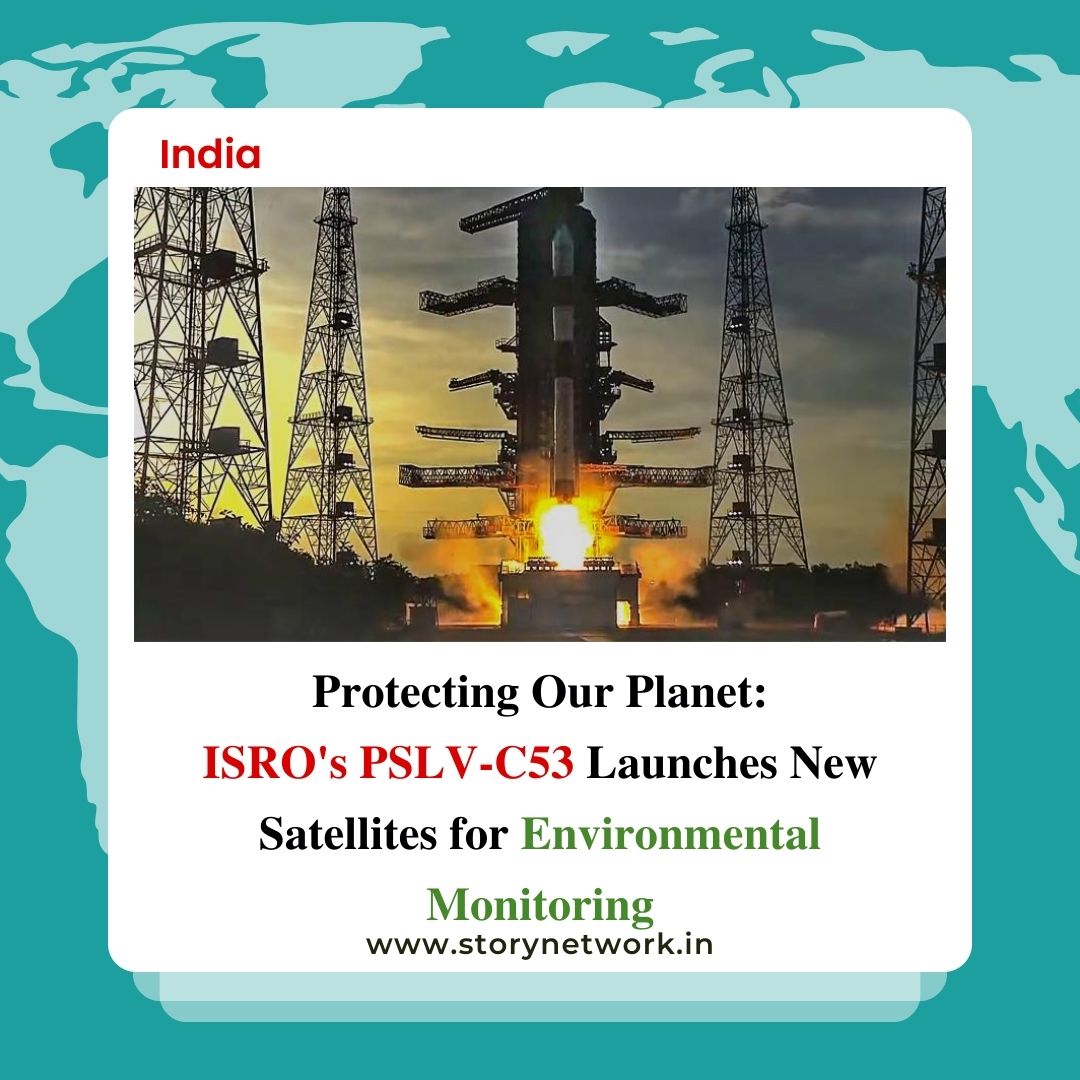The Indian Space Research Organisation (ISRO) once again demonstrated its prowess in launching satellites with the successful mission of PSLV-C53. The four-stage Polar Satellite Launch Vehicle, affectionately nicknamed “the workhorse” of ISRO, lifted off from the Satish Dhawan Space Centre in Sriharikota at 6:00 PM on 30th June 2022, carrying three important passengers:
- DS-EO, a 365 kg electro-optical Earth observation satellite developed by ISRO, designed for land classification, disaster relief and resource management.
- NeuSAR, a 155 kg high-resolution Synthetic Aperture Radar (SAR) satellite built by Singapore, capable of imaging through clouds and darkness, ideal for applications like environmental monitoring and maritime security.
- SCOOB-1, a 2.8 kg nanosatellite developed by Nanyang Technological University (NTU), Singapore, carrying an experimental payload to study lightning and radio communication.
Additional Information: Unpacking the Technical Marvels of PSLV-C53
The successful launch of the PSLV-C53 mission wasn’t just a spectacle; it was a symphony of meticulous engineering and cutting-edge technology. Let’s delve deeper into the technical marvels that propelled this mission to success:
The Workhorse Ascends:
The PSLV-C53, aptly nicknamed “the workhorse,” stands 44.4 meters tall and boasts a four-stage configuration. Each stage holds the key to a successful launch:
- First Stage: Powered by a solid propellant motor generating 4,800kN of thrust, this stage propels the rocket for the initial 110 seconds, lifting it out of Earth’s atmosphere.
- Second Stage: Equipped with liquid engines and fueled by UH-25 and NTO, this stage takes over after the first stage burnout and pushes the rocket towards its desired altitude.
- Third Stage: Using the same fuel combination as the second stage, this stage further increases the velocity and sets the spacecraft on its orbital path.
- Fourth Stage: This final stage houses the satellites and utilizes a small liquid engine to precisely inject them into their designated orbits.
Eyes on Earth:
DS-EO, the primary payload:
- Weighing 365 kg, this multi-spectral electro-optical satellite carries a high-resolution camera capable of capturing images in visible and near-infrared bands.
- The camera boasts a spatial resolution of 0.5 meters, meaning it can discern objects as small as 50 cm on Earth’s surface.
- With its multi-spectral capabilities, DS-EO can distinguish between different types of land cover, aiding in:
- Agricultural monitoring: Tracking crop health and predicting yields.
- Disaster management: Assessing flood and landslide damage and monitoring fire events.
- Urban planning: Mapping urban infrastructure and studying land use patterns.
- Resource management: Identifying mineral deposits and monitoring water resources.
NeuSAR: Seeing Through Darkness and Clouds:
- This 155 kg Singaporean satellite is equipped with a Synthetic Aperture Radar (SAR) capable of imaging Earth’s surface regardless of weather conditions or time of day.
- SAR uses radar pulses to generate high-resolution images, even penetrating cloud cover and darkness.
- NeuSAR’s applications include:
- Maritime security: Monitoring coastal areas and tracking illegal activities.
- Environmental monitoring: Assessing deforestation and mapping oil spills.
- Disaster management: Mapping flood inundation and monitoring landslides.
- Infrastructure monitoring: Detecting cracks and structural weaknesses in bridges and buildings.
SCOOB-1: A Tiny Titan of Science:
- This 2.8 kg nanosatellite, developed by Nanyang Technological University (NTU), Singapore, carries an experiment to study lightning and radio communication.
- It will measure electric field variations caused by lightning strikes and analyze their impact on radio signals.
- This data will be crucial for improving the design and deployment of communication systems in lightning-prone areas.
A Triumph of Collaboration:
The PSLV-C53 mission showcases the immense potential of international collaboration in space exploration. By successfully launching satellites for Singapore, ISRO strengthens its position as a reliable and cost-effective launch provider, attracting further business opportunities and building stronger partnerships.
More Than Just a Launch:
The PSLV-C53 mission is a testament to ISRO’s unwavering commitment to innovation and advancement. It paves the way for future milestones, including:
- Development of advanced launch vehicles: ISRO is constantly working on improving its existing rockets and developing new ones with higher capacities and capabilities.
- Human spaceflight: With the Gaganyaan mission on the horizon, India inches closer to sending astronauts into space, marking a monumental leap in its space program.
- Exploring the cosmos: Missions like Chandrayaan-3 and future endeavors to Mars and Venus demonstrate India’s unwavering ambition to unravel the mysteries of the universe.
A Flawless Execution:
The launch proceeded smoothly, with the four stages of the rocket performing flawlessly. After 18 minutes, the satellites were precisely injected into their intended orbits at an altitude of 570 km, marking a resounding success for the mission.
Importance of the Mission:
This successful launch not only strengthens ISRO’s position as a reliable and cost-effective launch provider but also holds significant benefits for India and its partner nations:
- Enhanced Earth Observation: DS-EO will provide high-resolution images of Earth’s surface, supporting agricultural monitoring, disaster management, infrastructure planning, and urban development.
- Boosting Scientific Collaboration: The mission facilitates collaborative research between India and Singapore, opening doors for future scientific cooperation in space exploration and technology development.
- Commercial Success: By successfully launching commercial satellites for Singapore, ISRO demonstrates its capabilities in the global space market, attracting further business opportunities and strengthening its financial standing.
A Stepping Stone to the Future:
The success of the PSLV-C53 mission is a testament to the dedication and expertise of ISRO scientists and engineers. It paves the way for further advancements in India’s space program, including:
- Developments in Launch Vehicles: ISRO is continuously working on improving its existing launch vehicles and developing new ones with higher capacity and capabilities.
- Focus on Human Spaceflight: The success of Gaganyaan mission’s experimental flights brings India closer to its ambitious goal of sending humans to space by 2024.
- Exploration of the Moon and Beyond: India’s lunar mission Chandrayaan-3 is in development, aiming to land a rover on the lunar surface. Exploration of Mars and Venus are also on the horizon.
Looking Ahead:
With its consistent successes and ambitious future plans, ISRO is poised to play a major role in the global space arena. The successful launch of PSLV-C53 is a clear indicator of India’s growing capabilities and its commitment to unlocking the potential of space for the benefit of humanity.
Table: Key Details of PSLV-C53 Mission
| Parameter | Description |
|---|---|
| Launch Vehicle | PSLV-C53 (Core Alone Variant) |
| Launch Date | 30th June 2022 |
| Launch Time | 6:00 PM IST |
| Launch Site | Satish Dhawan Space Centre, Sriharikota |
| Number of Satellites | 3 |
| Primary Payload | DS-EO (Earth Observation Satellite) |
| Secondary Payloads | NeuSAR (SAR Satellite) |
| Orbit Altitude | 570 km |
Conclusion:
The successful launch of PSLV-C53 marks a significant milestone for ISRO and paves the way for a brighter future in India’s space program. As India continues to soar high, the world watches with admiration and anticipation, eager to witness the next chapter in its remarkable journey towards the stars.
Read More:
Thriving Through Taste, Tenacity, and the Trials of COVID-19: How ‘Naaz Anjum’s Kitchen’ Went from Rs 80 to Rs 1 Lakh Monthly
Kainaz Messman’s Decade-Long Delight: Theobroma’s 78 Outlets, Rs 121 Crore, and Countless Smiles
Check out our section dedicated to India, where we celebrate inspirational changemakers, explore innovation, entrepreneurship, and sustainability, and delve into the impact of social and governance initiatives. From startups to Art & Culture, Education, Sports, Travel, Health, Lgbtqia+ spotlights, Reading & Books, Entertainment and lifestyle, our insightful articles provide valuable insights for small businesses and curious minds alike.





